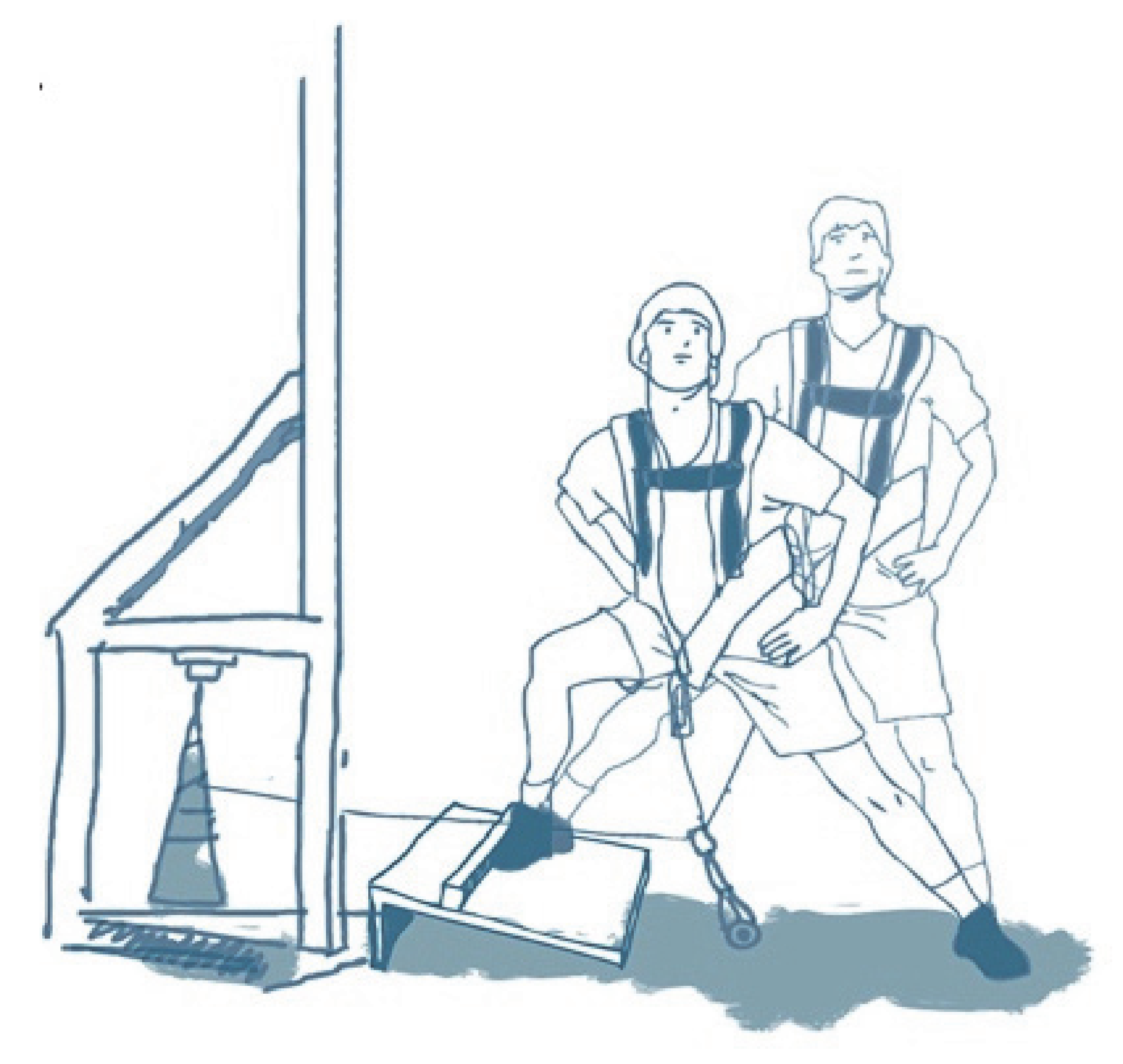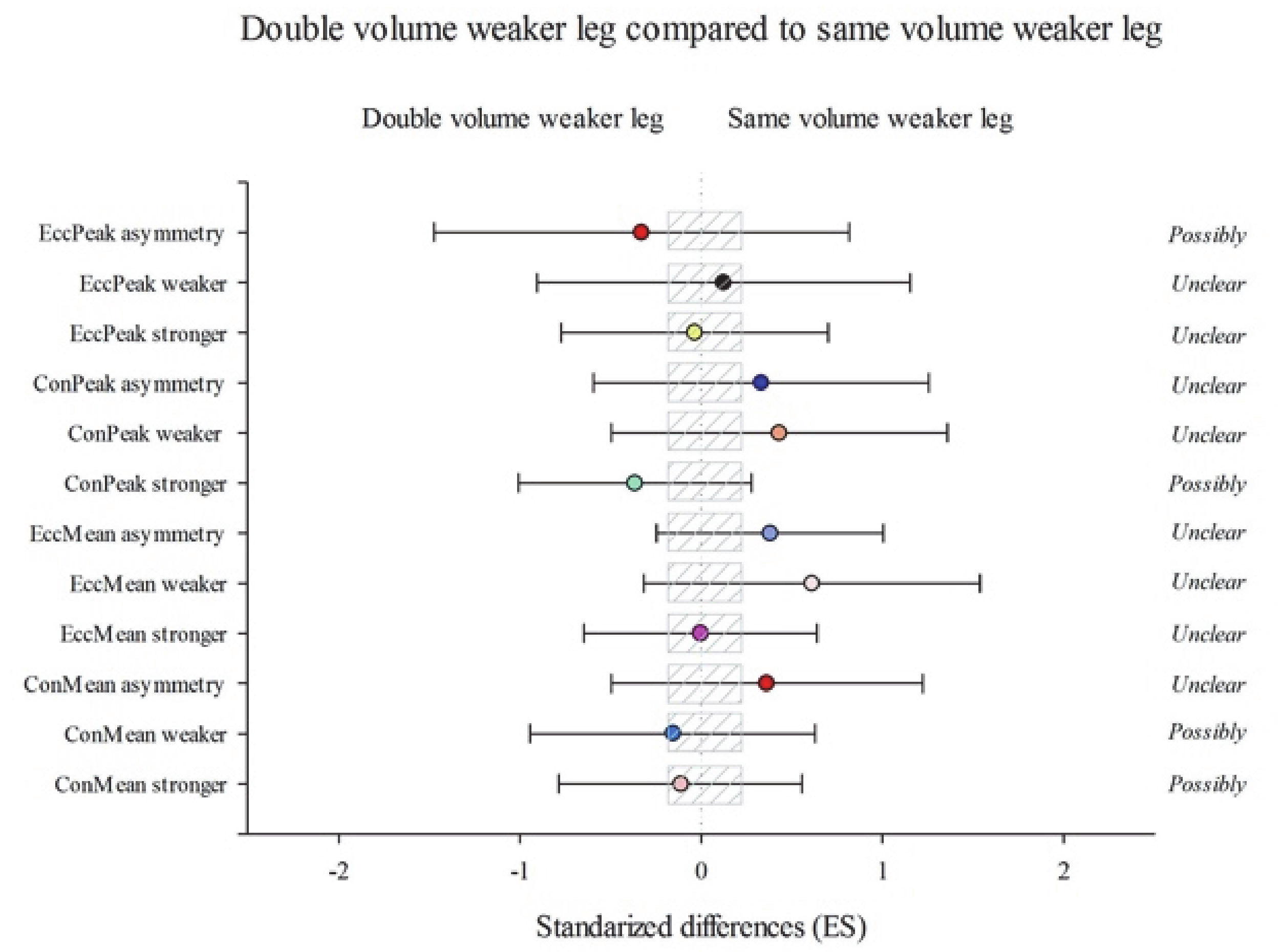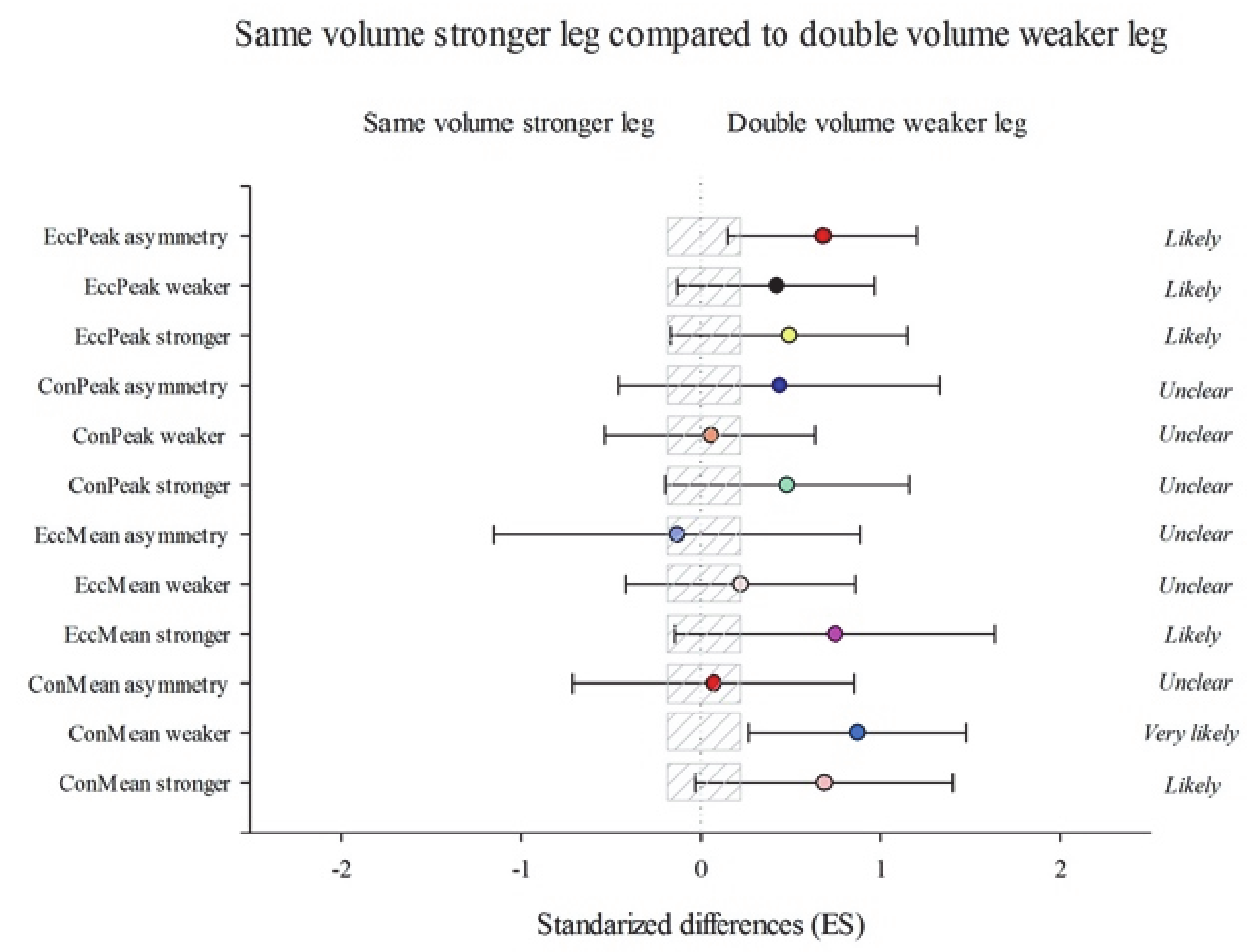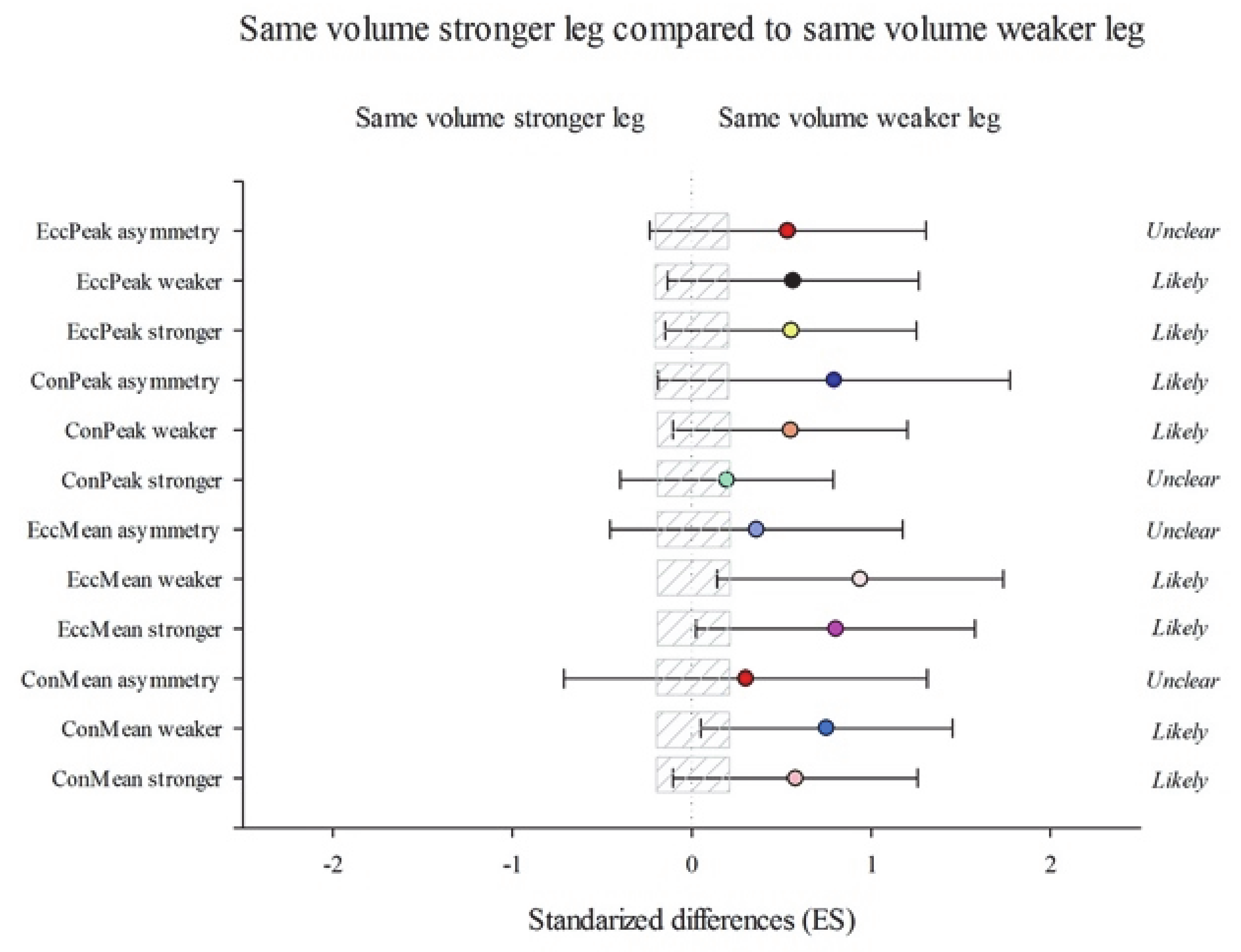Comparison of Three Eccentric Overload Training Strategies on Power Output and Interlimb Asymmetry in Youth Soccer Players
Abstract
:1. Introduction
2. Materials and Methods
2.1. Experimental Approach to the Problem
2.2. Subjects
2.3. Procedures
2.3.1. Training Intervention
2.3.2. Lateral Squat Test
2.4. Statistical Analyses
3. Results
4. Discussion
5. Conclusions
Author Contributions
Funding
Institutional Review Board Statement
Informed Consent Statement
Data Availability Statement
Acknowledgments
Conflicts of Interest
References
- Taylor, J.B.; Wright, A.A.; Dischiavi, S.L.; Townsend, M.A.; Marmon, A.R. Activity Demands During Multi-Directional Team Sports: A Systematic Review. Sports Med. 2017, 47, 2533–2551. [Google Scholar] [CrossRef] [PubMed]
- Silva, J.R.L.C.; Detanico, D.; Pupo, J.D.; Freitas, C.D.L.R. Bilateral asymmetry of knee and ankle isokinetic torque in soccer players u20 category. Rev. Bras. Cineantropom Desmpenho Hum. 2015, 17, 195–204. [Google Scholar] [CrossRef] [Green Version]
- Bishop, C.; Read, P.; McCubbine, J.; Turner, A. Vertical and Horizontal Asymmetries Are Related to Slower Sprinting and Jump Performance in Elite Youth Female Soccer Players. J. Strength Cond. Res. 2021, 35, 56–63. [Google Scholar] [CrossRef] [PubMed] [Green Version]
- Brown, S.R.; Cross, M.R.; Girard, O.; Brocherie, F.; Samozino, P.; Morin, J.-B. Kinetic Sprint Asymmetries on a non-motorised Treadmill in Rugby Union Athletes. Int. J. Sports Med. 2017, 38, 1017–1022. [Google Scholar] [CrossRef]
- Bishop, C.; Read, P.; Chavda, S.; Turner, A. Asymmetries of the Lower Limb: The Calculation Conundrum in Strength Training and Conditioning. Strength Cond. J. 2016, 38, 27–32. [Google Scholar] [CrossRef] [Green Version]
- Impellizzeri, F.M.; Rampinini, E.; Maffiuletti, N.; Marcora, S.M. A vertical jump force test for assessing bilateral strength asymmetry in athletes. Med. Sci. Sports Exerc. 2007, 39, 2044–2050. [Google Scholar] [CrossRef] [Green Version]
- Ardern, C.L.; Webster, K.E.; Taylor, N.F.; Feller, J.A. Return to the preinjury level of competitive sport after anterior cruciate ligament reconstruction surgery: Two-thirds of patients have not returned by 12 months after surgery. Am. J. Sports Med. 2011, 39, 538–543. [Google Scholar] [CrossRef]
- Bishop, C.; Turner, A.; Read, P. Effects of inter-limb asymmetries on physical and sports performance: A systematic review. J. Sports Sci. 2018, 36, 1135–1144. [Google Scholar] [CrossRef]
- Silva, J.R.; Rumpf, M.C.; Hertzog, M.; Castagna, C.; Farooq, A.; Girard, O.; Hader, K. Acute and Residual Soccer Match-Related Fatigue: A Systematic Review and Meta-analysis. Sports Med. 2018, 48, 539–583. [Google Scholar] [CrossRef]
- Howle, K.; Waterson, A.; Duffield, R. Injury Incidence and Workloads during congested Schedules in Football. Int. J. Sports Med. 2020, 41, 75–81. [Google Scholar] [CrossRef] [PubMed] [Green Version]
- Owen, A.; Dunlop, G.; Rouissi, M.; Chtara, M.; Paul, D.; Zouhal, H.; Wong, D.P. The relationship between lower-limb strength and match-related muscle damage in elite level professional European soccer players. J. Sports Sci. 2015, 33, 2100–2105. [Google Scholar] [CrossRef]
- Requena, B.; Garcia, I.; Requena, F.; de Villarreal, E.; Cronin, J. Relation-ship between traditional and ballistic squat exercise with vertical jump- ing and maximal sprinting. J. Strength Cond. Res. 2011, 25, 2193–2204. [Google Scholar] [CrossRef]
- Keiner, M.; Sander, A.; Wirth, K.; Schmidtbleicher, D. Long-Term Strength Training Effects on Change-of-Direction Sprint Performance. J. Strength Cond. Res. 2014, 28, 223–231. [Google Scholar] [CrossRef] [PubMed]
- Seitz, L.B.; Reyes, A.; Tran, T.T.; De Villarreal, E.S.; Haff, G.G. Increases in Lower-Body Strength Transfer Positively to Sprint Performance: A Systematic Review with Meta-Analysis. Sports Med. 2014, 44, 1693–1702. [Google Scholar] [CrossRef] [PubMed]
- Tous-Fajardo, J.; Gonzalo-Skok, O.; Arjol-Serrano, J.L.; Tesch, P. Enhancing change-of-direction speed in soccer players by functional inertial eccentric overload and vibration training. Int. J. Sports Physiol. Perform. 2016, 11, 66–73. [Google Scholar] [CrossRef] [PubMed]
- De Hoyo, M.; Sañudo, B.; Carrasco, L.; Mateo-Cortes, J.; Domínguez-Cobo, S.; Fernandes, O.D.J.; Del Ojo, J.J.; Gonzalo-Skok, O. Effects of 10-week eccentric overload training on kinetic parameters during change of direction in football players. J. Sports Sci. 2016, 34, 1380–1387. [Google Scholar] [CrossRef] [PubMed]
- Gonzalo-Skok, O.; Tous-Fajardo, J.; Valero-Campo, C.; Berzosa, C.; Bataller, A.V.; Arjol-Serrano, J.L.; Moras, G.; Mendez-Villanueva, A. Eccentric-Overload Training in Team-Sport Functional Performance: Constant Bilateral Vertical Versus Variable Unilateral Multidirectional Movements. Int. J. Sports Physiol. Perform. 2016, 12, 951–958. [Google Scholar] [CrossRef] [PubMed]
- Madruga-Parera, M.; Bishop, C.; Fort-Vanmeerhaeghe, A.; Beltran-Valls, M.R.B.; Skok, O.G.; Romero-Rodríguez, D. Interlimb Asymmetries in Youth Tennis Players. J. Strength Cond. Res. 2020, 34, 2815–2823. [Google Scholar] [CrossRef]
- Lovell, T.W.J.; Bocking, C.J.; Fransen, J.; Kempton, T.; Coutts, A.J. Factors affecting physical match activity and skill involvement in youth soccer. Sci. Med. Footb. 2018, 2, 58–65. [Google Scholar] [CrossRef] [Green Version]
- Gonzalo-Skok, O.; Tous-Fajardo, J.; Suarez-Arrones, L.; Arjol-Serrano, J.L.; Casajús, J.A.; Mendez-Villanueva, A. Single-leg power output and between-limbs imbalances in team-sport players: Unilateral versus bilateral combined resistance training. Int. J. Sports Physiol. Perform. 2017, 12, 106–114. [Google Scholar] [CrossRef]
- Gonzalo-Skok, O.; Moreno-Azze, A.; Arjol-Serrano, J.L.; Tous-Fajardo, J.; Bishop, C. A Comparison of 3 Different Unilateral Strength Training Strategies to Enhance Jumping Performance and Decrease Interlimb Asymmetries in Soccer Players. Int. J. Sports Physiol. Perform. 2019, 14, 1256–1264. [Google Scholar] [CrossRef]
- Petré, H.; Wernstål, F.; Mattsson, C.M. Effects of Flywheel Training on Strength-Related Variables: A Meta-analysis. Sports Med. Open 2018, 4, 1–15. [Google Scholar] [CrossRef]
- Madruga-Parera, M.; Bishop, C.; Fort-Vanmeerhaeghe, A.; Beato, M.; Gonzalo-Skok, O.; Romero-Rodríguez, D. Effects of 8-weeks of iso-inertial vs. cable resistance training on motor skills performance and inter-limb asymmetries. J. Strength Cond. Res. 2020. [Google Scholar] [CrossRef]
- Fiorilli, G.; Mariano, I.; Iuliano, E.; Giombini, A.; Ciccarelli, A.; Buonsenso, A.; Calcagno, G.; Di Cagno, A. Isoinertial eccentric-overload training in young soccer players: Effects on strength, sprint, change of direction, agility and soccer shooting precision. J. Sports Sci. Med. 2020, 19, 213–223. [Google Scholar] [PubMed]
- Sabido, R.; Hernández-Davó, J.L.; Botella, J.; Navarro, A.; Tous-Fajardo, J. Effects of adding a weekly eccentric-overload training session on strength and athletic performance in team-handball players. Eur. J. Sport Sci. 2017, 17, 530–538. [Google Scholar] [CrossRef]
- Sabido, R.; Hernández-Davó, J.L.; Pereyra-Gerber, G.T. Influence of different inertial loads on basic training variables during the flywheel squat exercise. Int. J. Sports Physiol. Perform. 2018, 13, 482–489. [Google Scholar] [CrossRef] [PubMed]
- Davó, J.L.H.; Monteagudo, P.; Sabido, R. Comparison of Six Weeks Eccentric Overload Training between Bilateral and Unilateral Squat in Basketball Players/Comparación de Los Efectos de Seis Semanas de Entrenamiento con Sobrecarga Excéntrica Bilateral Y Unilateral en Jugadores de Baloncesto. Mot. Eur. J. Hum. Mov. 2018, 40, 111–121. [Google Scholar]
- Núñez, F.J.; De Hoyo, M.; López, A.M.; Sañudo, B.; Otero-Esquina, C.; Sanchez, H.; Gonzalo-Skok, O. Eccentric-concentric Ratio: A Key Factor for Defining Strength Training in Soccer. Int. J. Sports Med. 2019, 40, 796–802. [Google Scholar] [CrossRef] [PubMed]
- Sannicandro, I.; Cofano, G.; Rosa, R.A.; Piccinno, A. Balance Training Exercises Decrease Lower-Limb Strength Asymmetry in Young Tennis Players. J. Sports Sci. Med. 2014, 13, 397–402. [Google Scholar] [PubMed]
- Pardos Mainer, E.; Casajus, J.A.; Bishop, C.; Gonzalo-Skok, O. Effects of Combined Strength an Power Training on Physical Performance and Inter-limb Asymmetries in Adolescent Female Soccer Players. Int. J. Sports Physiol. Perform. 2019, 15, 1147–1155. [Google Scholar] [CrossRef] [PubMed]
- Cunningham, J.B.; McCrum-Gardner, E. Power, effect and sample size using GPower: Practical issues for researchers and members of research ethics committees. Evid. Based Midwifery 2007, 5, 132–137. [Google Scholar]
- Sabido, R.; Hernández-Davó, J.L.; García-Valverde, A.; Marco, P.; Asencio, P. Influence of the Strap Rewind Height During a Conical Pulley Exercise. J. Hum. Kinet. 2020, 74, 109–118. [Google Scholar] [CrossRef]
- Waldén, M.; Krosshaug, T.; Bjørneboe, J.; Andersen, T.E.; Faul, O.; Hägglund, M. Three distinct mechanisms predominate in non-contact anterior cruciate ligament injuries in male professional football players: A systematic video analysis of 39 cases. Br. J. Sports Med. 2015, 49, 1452–1460. [Google Scholar] [CrossRef] [PubMed] [Green Version]
- Koo, T.K.; Li, M.Y. A Guideline of Selecting and Reporting Intraclass Correlation Coefficients for Reliability Research. J. Chiropr. Med. 2016, 15, 155–163. [Google Scholar] [CrossRef] [PubMed] [Green Version]
- Cormack, S.J.; Newton, R.U.; McGuigan, M.R.; Doyle, T.L.A. Reliability of Measures Obtained During Single and Repeated Countermovement Jumps. Int. J. Sports Physiol. Perform. 2008, 3, 131–144. [Google Scholar] [CrossRef] [PubMed] [Green Version]
- Hopkins, W.G.; Marshall, S.W.; Batterham, A.M.; Hanin, J. Progressive Statistics for Studies in Sports Medicine and Exercise Science. Med. Sci. Sports Exerc. 2009, 41, 3–12. [Google Scholar] [CrossRef] [Green Version]
- Bishop, C.; Read, P.; Lake, J.; Chavda, S.; Turner, A. Interlimb Asymmetries: Understanding How to Calculate Differences From Bilateral and Unilateral Tests. Strength Cond. J. 2018, 40, 1–6. [Google Scholar] [CrossRef] [Green Version]
- Askling, C.; Karlsson, J.; Thorstensson, A. Hamstring injury occurrence in elite soccer players after preseason strength training with eccentric overload. Scand. J. Med. Sci. Sports 2003, 13, 244–250. [Google Scholar] [CrossRef]
- de Hoyo, M.; Sañudo, B.; Carrasco, L.; Domínguez-Cobo, S.; Mateo-Cortes, J.; Cadenas-Sánchez, M.M.; Nimphius, S. Effects of Traditional Versus Horizontal Inertial Flywheel Power Training on Common Sport-Related Tasks. J. Hum. Kinet. 2015, 47, 155–167. [Google Scholar] [CrossRef] [Green Version]
- Gonzalo-Skok, O.; Sánchez-Sabaté, J.; Izquierdo-Lupón, L.; De Villarreal, E.S. Influence of force-vector and force application plyometric training in young elite basketball players. Eur. J. Sport Sci. 2018, 19, 305–314. [Google Scholar] [CrossRef]
- Bishop, C.; Lake, J.; Loturco, I.; Papadopoulos, K.; Turner, A.; Read, P. Interlimb Asymmetries: The Need for an Individual Approach to Data Analysis. J. Strength Cond. Res. 2018, 40, 1–6. [Google Scholar] [CrossRef] [Green Version]




| Week | Session | Sets/Leg | Repetitions/Set/Leg | Speed/Force Ratio |
|---|---|---|---|---|
| 1 | Familiarization | |||
| 2 | Reliability test #1 | |||
| 3 | Reliability test #2 | |||
| 4 | Reliability test #3/Pre-test | 2 | 1 out of 4 | |
| 5–6 | Session 1–2 | 2 | 6 | 1 out of 4 |
| 7–8 | Session 3–4 | 2 | 8 | 1 out of 4 |
| 9–10 | Session 5–6 | 2 | 8 | 2 out of 4 |
| 11–12 | Session 7–8 | 2 | 10 | 2 out of 4 |
| 13–14 | Session 9–10 | 2 | 10 | 3 out of 4 |
| 15 | Post test | 2 | 1 out of 4 |
| TEST | TEM (90% CL) | CV (90% CL) | ICC (90% CL) |
|---|---|---|---|
| ConMean stronger | 71.45 (59.76; 89.51) | 19.46 (16.03; 24.95) | 0.75 (0.6; 0.85) |
| ConMean weaker | 51.81 (43.34; 64.91) | 16.86 (13.92; 21.56) | 0.78 (0.64; 0.87) |
| EccMean stronger | 76.9 (64.32; 96.33) | 24.87 (20.41; 32.08) | 0.66 (0.47; 0.79) |
| EccMean weaker | 56.32 (47.11; 70.56) | 18.97 (15.64; 24.31) | 0.76 (0.61; 0.86) |
| ConPeak stronger | 132.45 (110.78; 165.93) | 18.88 (15.57; 24.2) | 0.8 (0.67; 0.88) |
| ConPeak weaker | 93.11 (77.88; 116.65) | 16.28 (13.44; 20.79) | 0.81 (0.68; 0.89) |
| EccPeak stronger | 159.9 (133.74; 200.31) | 18.14 (14.96; 23.23) | 0.84 (0.73; 0.9) |
| EccPeak weaker | 128.84 (107.76; 161.4) | 17.48 (14.43; 22.36) | 0.82 (0.7; 0.89) |
| SVW = SAME VOLUME, WEAKER LEG (n = 10) | DVW = DOUBLE VOLUME, WEAKER LEG (n = 11) | SVS = SAME VOLUME, STRONGER LEG (n = 14) | ||||||||||
|---|---|---|---|---|---|---|---|---|---|---|---|---|
| Variables | PRE-TEST | POST-TEST | ES (CL90%) | p | PRE-TEST | POST-TEST | ES (CL90%) | p | PRE-TEST | POST-TEST | ES (CL90%) | p |
| ConMean stronger (W) | 439.30 (±169.02) | 747.22 (±203.79) | 1.49 (1.1; 1.87) | <0.01 | 493.06 (±211.14) | 807.29 (±200.33) | 1.07 (0.64; 1.5) | <0.01 | 427.44 (±124.88) | 648.45 (±178.59) | 1.16 (0.81; 1.5) | <0.01 |
| ConMean weaker (W) | 306.91 (±202.13) | 748.46 (±214.19) | 2.24 (1.74; 2.74) | <0.01 | 358.72 (±211.22) | 796.37 (±191.34) | 2.04 (1.45; 2.64) | <0.01 | 339.79 (±138.56) | 636.84 (±166.9) | 1.53 (1.22; 1.85) | <0.01 |
| ConMean asymmetry (%) | 32.9 (±37.08) | 7.84 (±5.38) | 0.89 (0.19; 1.58) | 0.04 | 32.56 (±36.35) | 13.7 (±9.99) | 0.43 (−0.15; 1.01) | 0.18 | 20.74 (±24.85) | 12.23 (±9.56) | 0.45 (−0.31; 1.2) | 0.54 |
| EccMean stronger (W) | 404.36 (±146.44) | 669.52 (±176.23) | 1.52 (1.15; 1.9) | <0.01 | 456.18 (±161.17) | 705.89 (±165.03) | 1.17 (0.71; 1.63) | <0.01 | 391.96 (±114.86) | 577.28 (±154.35) | 1.00 (0.71; 1.29) | <0.01 |
| EccMean weaker (W) | 344.28 (±138.17) | 667.14 (±178.9) | 1.97 (1.53; 2.4) | <0.01 | 443.38 (±165.13) | 656.93 (±131.9) | 1.08 (0.71; 1.45) | <0.01 | 367.91 (±114.39) | 581.17 (±148) | 1.16 (0.85; 1.47) | <0.01 |
| EccMean asymmetry (%) | 26.78 (±29.57) | 11.43 (±6.36) | 0.81 (−0.03; 1.65) | 0.19 | 19.61 (±16.58) | 13.65 (±6.23) | 0.01 (−1.02; 1.04) | 0.27 | 14.12 (±7.87) | 9.37 (±9.25) | 0.63 (−0.02; 1.28) | 0.24 |
| ConPeak stronger (W) | 788.95 (±307.85) | 1167.04 (±250.03) | 1.14 (0.68; 1.61) | <0.01 | 916.66 (±434.15) | 1348.97 (±322.06) | 0.92 (0.43; 1.4) | <0.01 | 717.06 (±195.93) | 1085.83 (±347.05) | 1.25 (0.83; 1.67) | <0.01 |
| ConPeak weaker (W) | 669.49 (±313.97) | 1217.9 (±302.24) | 1.63 (1.13; 2.14) | <0.01 | 872.23 (±447.98) | 1176.24 (±209.55) | 0.77 (0.33; 1.21) | 0.03 | 667.53 (±192.14) | 1072.01 (±368.35) | 1.33 (0.95; 1.71) | <0.01 |
| ConPeak asymmetry (%) | 32.02 (±28.36) | 6.47 (±4.94) | 1.6 (0.78; 2.41) | 0.01 | 20.63 (±16.33) | 16.43 (±11.28) | 0.07 (−0.81; 0.94) | 0.45 | 13.68 (±9.21) | 10.49 (±8.98) | 0.39 (−0.28; 1.06) | 0.44 |
| EccPeak stronger (W) | 938.72 (±427.89) | 1581.07 (±418.54) | 1.31 (0.77; 1.86) | <0.01 | 1034.55 (±436.39) | 1645.6 (±421.01) | 1.12 (0.68; 1.57) | <0.01 | 850.57 (±297.64) | 1311.17 (±466.67) | 1.08 (0.71; 1.45) | <0.01 |
| EccPeak weaker (W) | 834.25 (±397.72) | 1560.83 (±522.17) | 1.64 (1.18; 2.09) | <0.01 | 1010.49 (±450.81) | 1583.75 (±334.42) | 1.11 (0.72; 1.5) | <0.01 | 812.37 (±311.59) | 1311.07 (±451.86) | 1.19 (0.83; 1.56) | <0.01 |
| EccPeak asymmetry (%) | 27.32 (±29.6) | 14.36 (±11.17) | 0.34 (−0.46; 1.13) | 0.39 | 20.46 (±12.81) | 12.2 (±10.4) | 0.68 (0.09; 1.27) | 0.11 | 13.32 (±11.39) | 12.6 (±10.67) | 0.08 (−0.66; 0.82) | 0.89 |
Publisher’s Note: MDPI stays neutral with regard to jurisdictional claims in published maps and institutional affiliations. |
© 2021 by the authors. Licensee MDPI, Basel, Switzerland. This article is an open access article distributed under the terms and conditions of the Creative Commons Attribution (CC BY) license (https://creativecommons.org/licenses/by/4.0/).
Share and Cite
Moreno-Azze, A.; Arjol-Serrano, J.L.; Falcón-Miguel, D.; Bishop, C.; Gonzalo-Skok, O. Comparison of Three Eccentric Overload Training Strategies on Power Output and Interlimb Asymmetry in Youth Soccer Players. Int. J. Environ. Res. Public Health 2021, 18, 8270. https://doi.org/10.3390/ijerph18168270
Moreno-Azze A, Arjol-Serrano JL, Falcón-Miguel D, Bishop C, Gonzalo-Skok O. Comparison of Three Eccentric Overload Training Strategies on Power Output and Interlimb Asymmetry in Youth Soccer Players. International Journal of Environmental Research and Public Health. 2021; 18(16):8270. https://doi.org/10.3390/ijerph18168270
Chicago/Turabian StyleMoreno-Azze, Alejandro, José Luis Arjol-Serrano, David Falcón-Miguel, Chris Bishop, and Oliver Gonzalo-Skok. 2021. "Comparison of Three Eccentric Overload Training Strategies on Power Output and Interlimb Asymmetry in Youth Soccer Players" International Journal of Environmental Research and Public Health 18, no. 16: 8270. https://doi.org/10.3390/ijerph18168270






